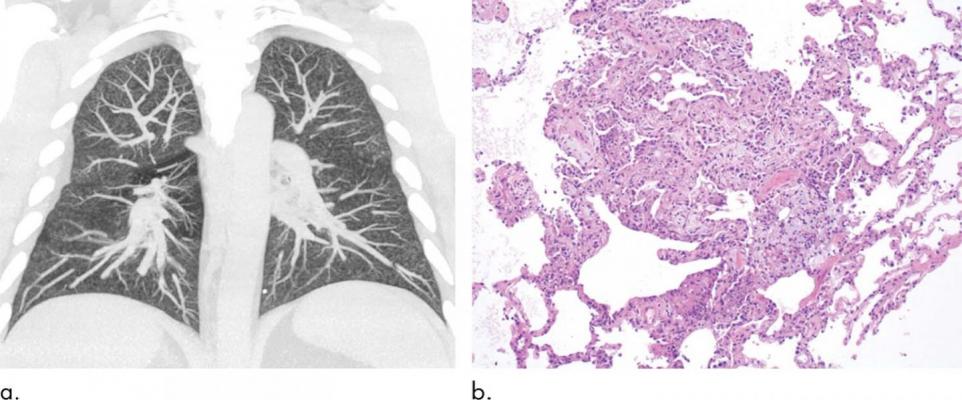
Images show electronic cigarette or vaping product use-associated lung injury in a 32-year-old man with history of vaping who presented with fevers and night sweats for 1 week. (a) Coronal maximum intensity projection image shows diffuse centrilobular nodularity. (b) Histologic sections of his transbronchial cryobiopsy showed distinctive micronodular pattern of airway-centered organizing pneumonia, corresponding to centrilobular nodularity seen at CT. Similar imaging and pathologic findings have been described in patients with smoke synthetic cannabinoids. Image courtesy of Radiological Society of North America (RSNA)
January 28, 2020 — Pulmonary imaging is important in the diagnosis of the acute lung injury associated with vaping, known as electronic cigarette or vaping product use-associated lung injury (EVALI), according to a special review article published in the journal Radiology. The report outlines what is currently known about this condition and discusses remaining questions.
Although e-cigarettes have been often marketed as a safer alternative to traditional cigarettes, EVALI has emerged as a serious and sometimes fatal complication of vaping.
Radiologists play a key role in the evaluation of suspected EVALI. Accurate identification of the condition allows for prompt medical treatment, which may decrease the severity of injury in some patients.
“Rapid clinical and/or radiologic recognition of EVALI allows clinicians to treat patients expeditiously and provide supportive care,” said Seth Kligerman, M.D., associate professor at UC San Diego School of Medicine and division chief of cardiothoracic radiology at UC San Diego Health in San Diego, Calif. “Although detailed clinical studies are lacking, some patients with EVALI rapidly improve after the administration of corticosteroids. Additionally, making the correct diagnosis may prevent unnecessary therapies and procedures, which themselves can lead to complications.”
Despite ongoing investigations by public health officials, the exact cause of EVALI remains unclear. What is currently known is that most patients are young adult and adolescent men. Over 80 percent of EVALI patients report vaping tetrahydrocannabinol (THC) or cannabidiol CBD containing compounds.
Patients with EVALI typically have a combination of respiratory and gastrointestinal symptoms, as well as general symptoms like fever or fatigue. Chest CT findings in EVALI can be variable but most commonly show a pattern of diffuse lung injury with sparing of the periphery of the lungs. EVALI is a diagnosis of exclusion. The patient must have a history of vaping within 90 days and abnormal findings on chest imaging, but other possible causes for the patient’s symptoms must be eliminated.
Kligerman also notes that some patients may present to the emergency department with relatively mild symptoms or radiologic findings.
“If EVALI is not diagnosed in a timely manner, patients may continue vaping after leaving the doctor’s office, clinic or emergency department which could lead to worsening lung injury,” he said.
The article cautions that aside from EVALI, vaping may pose long-term health risks. Nicotine and THC addiction, cardiovascular disease and chronic pulmonary injury are all potential consequences of e-cigarette use and are particularly concerning in the predominantly younger population that is associated with vaping.
“Right now, we do not know the long-term effects of vaping, as it is still a relatively new method of nicotine and THC delivery, and there are countless variables involved which further confound our understanding of what is happening on a patient-specific level,” Kligerman said.
He added that while recent studies have shown an association between vaping and the development of asthma, chronic bronchitis and chronic obstructive pulmonary disease, these studies have only shown an association and not causation.
“Although I am hesitant to speculate on specifics as we just do not have the data, I would not be surprised if vaping is directly linked to many of the chronic pulmonary and cardiovascular diseases commonly associated with traditional cigarette smoking,” Kligerman said.
“The link between vaping and lung cancer is unknown at this point,” he noted.
Studies with long-term follow up will be needed to evaluate EVALI patients for these conditions and others, including malignancies, that may require longer term vaping exposure to develop.
For more information: www.rsna.org
Related content:
Radiology: Cardiothoracic Imaging Publishes Special Report on Vaping
Best Practice Treatment Guidelines Help Doctors Identify, Treat Vaping-associated Lung Injuries



 December 17, 2025
December 17, 2025 









